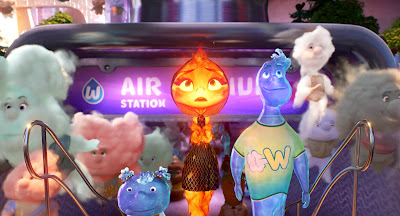I remember the first time I saw the trailer for Pixar Animation Studios’ Elemental a few months ago. It was at a theater with a group of friends who, like myself, had grown up with the first wave of Pixar films in the late nineties and early two-thousands. We all had fond memories of the Little California Studio that Could—the company who beat the seemingly invincible Walt Disney Animation Studios at their own game over and over at the box office and the Oscars. While the Mouse floundered with bland, forgettable comedies, Pixar gained a reputation for movies unafraid to exercise the audience’s hearts and tear ducts. Once, the release of a new Pixar movie was an Event with a capital “E.” Then came their 2006 merger with Disney and something…changed. While still capable of the occasional film with the old Pixar magic—Inside Out (2015) and Coco (2017) come immediately to mind—the innovators who gave the world talking toys, soft-shoeing robots, and balloon houses became a conveyor belt of Good-Not-Great sequels, prequels, and direct-to-streaming releases. When the credits of the Elemental trailer flashed, my friends and I sat in bewildered silence, looked at each other, and laughed.
Perhaps we were unfair. By all accounts, Elemental wasn’t the Pixar-on-autopilot cash-grab the trailer seemed to suggest. Pitched way back in 2015 and largely based on director Peter Sohn’s memories of growing up in the States the child of Korean immigrants, the film is obviously a labor of love with the highest (and noblest) artistic intentions. It’s the story of two star-crossed lovers—one a lower-class fire element named Ember Lumen (Leah Lewis) and the other an upper-class water element named Wade Ripple (Mamoudou Athie)—living in Element City, a metropolitan wonderland peopled with anthropomorphic versions of the four classical elements of fire, water, earth, and air. After a painful meet-cute where Wade, a city inspector, almost puts Ember’s family’s shop out of business—long story—the two team up to solve a mystery threatening the entire fire element quarter of the city. Oh, and somewhere in there they fall madly in love. Elemental takes bold swings at such weighty topics as racism, the immigrant experience, class differences, and escaping parental expectations (the last being one of Pixar’s favorite themes as far back as Finding Nemo and The Incredibles in the early two-thousands). It also has the distinction of being one of the only Pixar romantic comedies since WALL-E (2008).
Unfortunately, Elemental isn’t particularly good. But it’s not bad, either, which is the problem. In today’s crowded animation marketplace, the most dangerous thing a film can be is mediocre: great films are remembered for their excellence, bad films for their notoriety. But mediocre films? Those are quickly forgotten. Frankly, I don’t see anyone remembering this film in a year or two any more than other Pixar missteps like The Good Dinosaur (2015) and Onward (2020). Too many of the story beats are cookie-cutter predictable, right down to Ember’s contrived falling out with her doting father to Ember’s even more contrived break-up with Wade at the start of the third act. Watching it, I couldn’t escape the impression that I was seeing something Frankensteined together from other, better Pixar movies.
Instead, Elemental is at its best when it steps back from the plot and lets the audience drink in the incredible world-building and art direction. Element City is one of the most dazzlingly realized locations in any Pixar film with exquisite, near obsessive detail poured into its every nook and cranny. Unlike many animated cities that feel like clones of real-world locations like New York City with a few strange buildings thrown into the background for flavor, everything about Element City feels constructed with a city planner’s eye for accommodating real-life creatures of fire, water, earth, and air. Consider, for example, the fire element quarter of the city where Ember lives. As the city was originally built with water elementals in mind, their neighborhood was reverse engineered between a series of drained canals. Since the city’s subway system is essentially a giant log flume ride, the sidewalks underneath their elevated lines are covered with drains to catch and dispose of spilled water so it doesn’t harm the fiery inhabitants. This is world-building of the highest degree, and I haven’t even mentioned the glass tower swimming pools of the water elementals, the tree-filled offices of the earth elementals, or the sky-high spherical sports stadiums of the air elementals.
Element City deserved a better story. The narrative’s need to shoehorn all its weighty themes like racism and classism around its uneven romance fails the latter at the expense of the former. It’s not that you can’t make a good romantic comedy that explores these ideas—this just isn’t one of them. I’ve heard that during production certain story ideas were nixed because the filmmakers wanted to save them for a potential sequel. Despite Elemental’s mediocrity, I hope it gets made, if only because I want to see this creative team take a crack at a better story worthy of Element City.
No comments:
Post a Comment